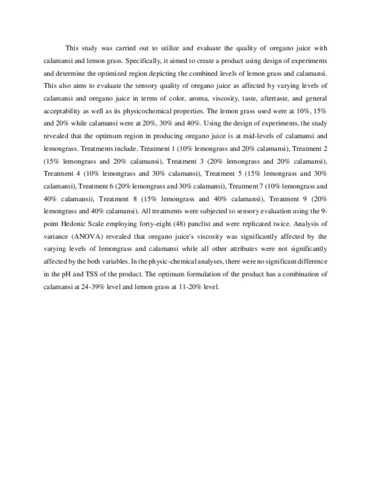Development and evaluation of Oregano (Origanum vulgare) juice as affected by varying levels of Calamansi (Citrofortunella microcarpa) and Lemon grass (Cymbopogoni citratus)
| dc.contributor.advisor | Leccio, Clyde Dwynelh G. | |
| dc.contributor.author | Arcibal, Hervin Jr. A. | |
| dc.contributor.author | Dela Cruz, Mark Anthony H. | |
| dc.contributor.author | Bibaoco, Jameson C. | |
| dc.contributor.author | Lozada, Ella O. | |
| dc.date.accessioned | 2024-04-04T07:31:00Z | |
| dc.date.available | 2024-04-04T07:31:00Z | |
| dc.date.issued | 2023-06 | |
| dc.identifier.citation | Arcibal, H.A., Dela Cruz, M.A.H., Bibaoco, J.C., & Lozada, E.O. (2023). Development and evaluation of Oregano (Origanum vulgare) juice as affected by varying levels of Calamansi (Citrofortunella microcarpa) and Lemon grass (Cymbopogoni citratus) [Undergraduate thesis, Capiz State University Mambusao Satellite College]. CAPSU Institutional Repository. | en |
| dc.identifier.uri | https://repository.capsu.edu.ph/handle/123456789/302 | |
| dc.description.abstract | This study was carried out to utilize and evaluate the quality of oregano juice with calamansi and lemon grass. Specifically, it aimed to create a product using design of experiments and determine the optimized region depicting the combined levels of lemon grass and calamansi. This also aims to evaluate the sensory quality of oregano juice as affected by varying levels of calamansi and oregano juice in terms of color, aroma, viscosity, taste, aftertaste, and general acceptability as well as its physicochemical properties. The lemon grass used were at 10%, 15% and 20% while calamansi were at 20%, 30% and 40%. Using the design of experiments, the study revealed that the optimum region in producing oregano juice is at mid-levels of calamansi and lemongrass. Treatments include. Treatment 1 (10% lemongrass and 20% calamansi), Treatment 2 (15% lemongrass and 20% calamansi), Treatment 3 (20% lemongrass and 20% calamansi), Treatment 4 (10% lemongrass and 30% calamansi), Treatment 5 (15% lemongrass and 30% calamansi), Treatment 6 (20% lemongrass and 30% calamansi), Treatment 7 (10% lemongrass and 40% calamansi), Treatment 8 (15% lemongrass and 40% calamansi), Treatment 9 (20% lemongrass and 40% calamansi). All treatments were subjected to sensory evaluation using the 9-point Hedonic Scale employing forty-eight (48) panclist and were replicated twice. Analysis of variance (ANOVA) revealed that oregano juice's viscosity was significantly affected by the varying levels of lemongrass and calamansi while all other attributes were not significantly affected by the both variables. In the physic-chemical analyses, there were no significant difference in the pH and TSS of the product. The optimum formulation of the product has a combination of calamansi at 24-39% level and lemon grass at 11-20% level. | en |
| dc.language.iso | en | en |
| dc.publisher | Mambusao Satellite College, Capiz State University | en |
| dc.subject | Oregano | en |
| dc.subject | Calamansi | en |
| dc.subject | Lemongrass | en |
| dc.subject | Herbal juice | en |
| dc.subject.lcsh | Oregano | en |
| dc.subject.lcsh | Lemongrass | en |
| dc.subject.lcsh | Herbs -- Therapeutic use | en |
| dc.subject.lcsh | Sensory evaluation | en |
| dc.subject.lcsh | Medicinal plants | en |
| dc.title | Development and evaluation of Oregano (Origanum vulgare) juice as affected by varying levels of Calamansi (Citrofortunella microcarpa) and Lemon grass (Cymbopogoni citratus) | en |
| dc.type | Thesis | en |
| dc.contributor.chair | Leccio, Clyde Dwynelh G. | |
| dc.contributor.committeemember | Bobier, Lecel O. | |
| dc.contributor.committeemember | Ticar, Rhodora L. | |
| thesis.degree.discipline | Food Technology | en |
| thesis.degree.grantor | Capiz State University Mambusao Satellite College | en |
| thesis.degree.level | Undergraduate | en |
| thesis.degree.name | Bachelor of Science in Food Technology | en |
| dc.subject.agrovoc | Oregano | en |
| dc.subject.agrovoc | Calamansi | en |
| dc.subject.agrovoc | Lemon grass | en |
| thesis.degree.department | Food Technology Department | en |
| dc.subject.scientificname | Origanum vulgare | en |
| dc.subject.scientificname | Citrofortunella microcarpa | en |
| dc.subject.scientificname | Cymbopogon citratus | en |

